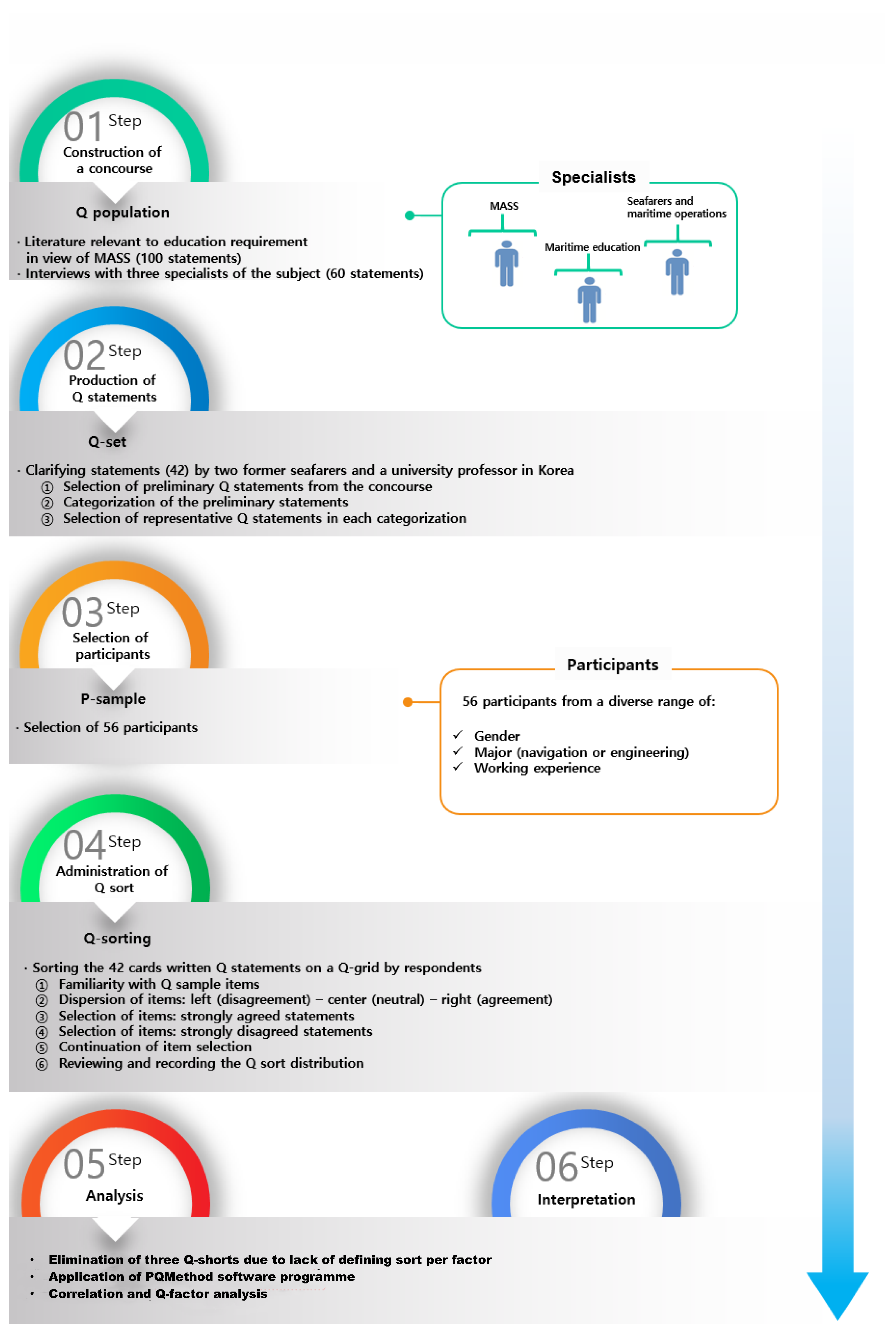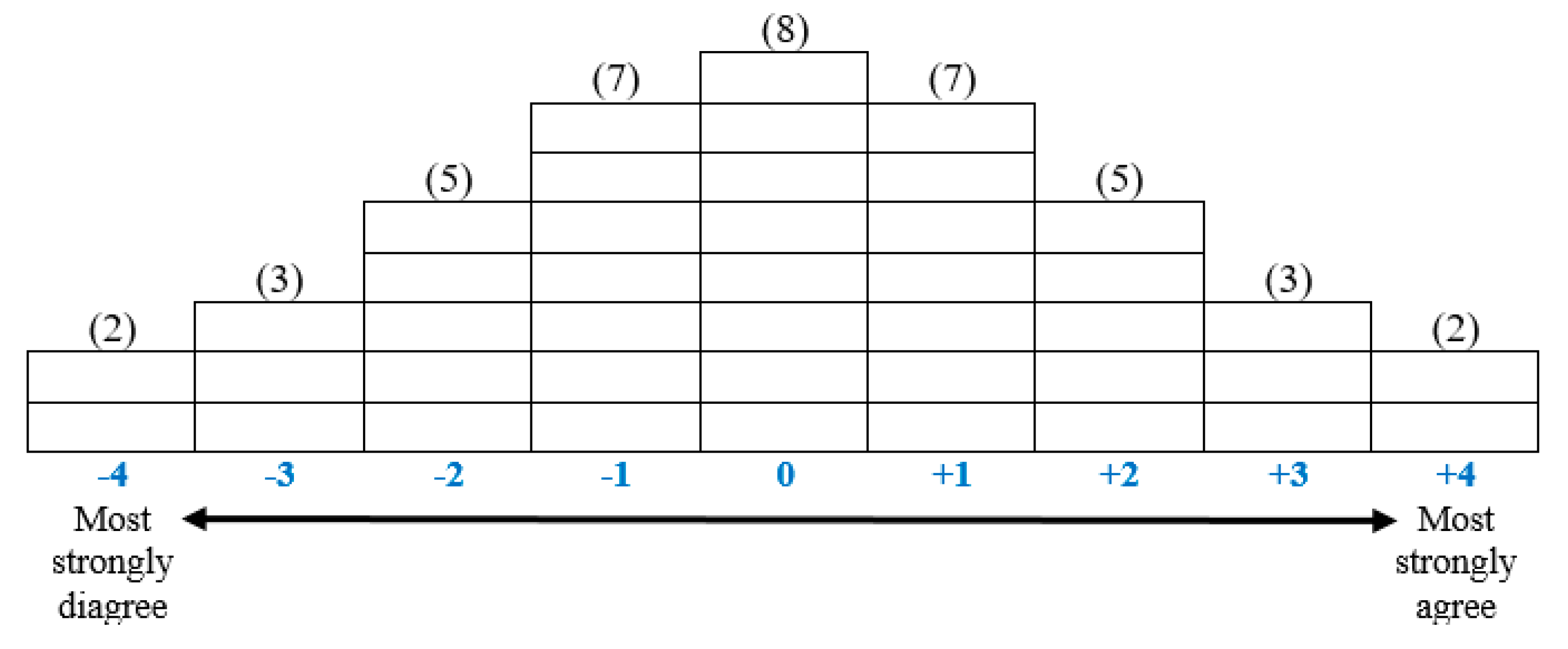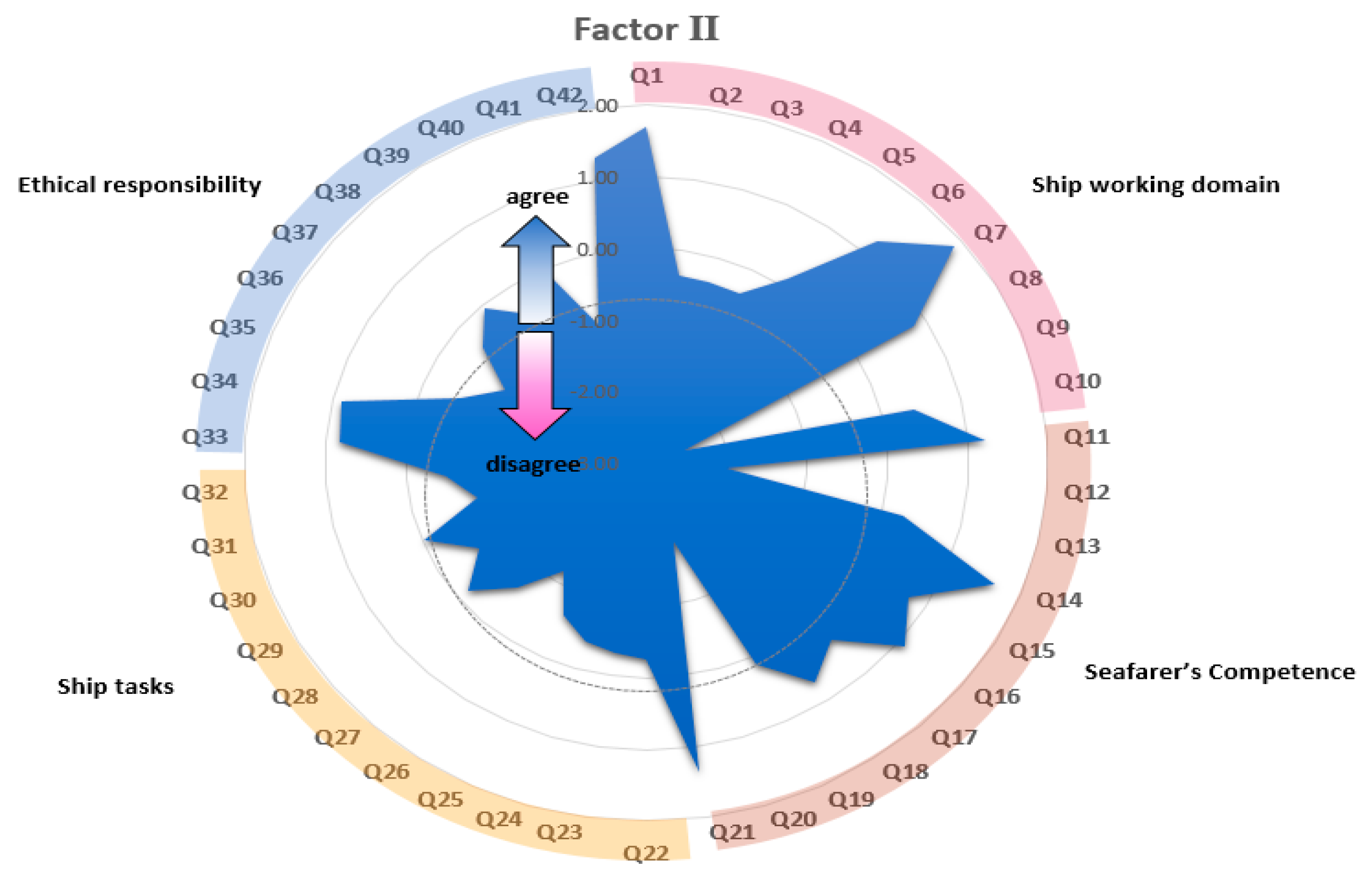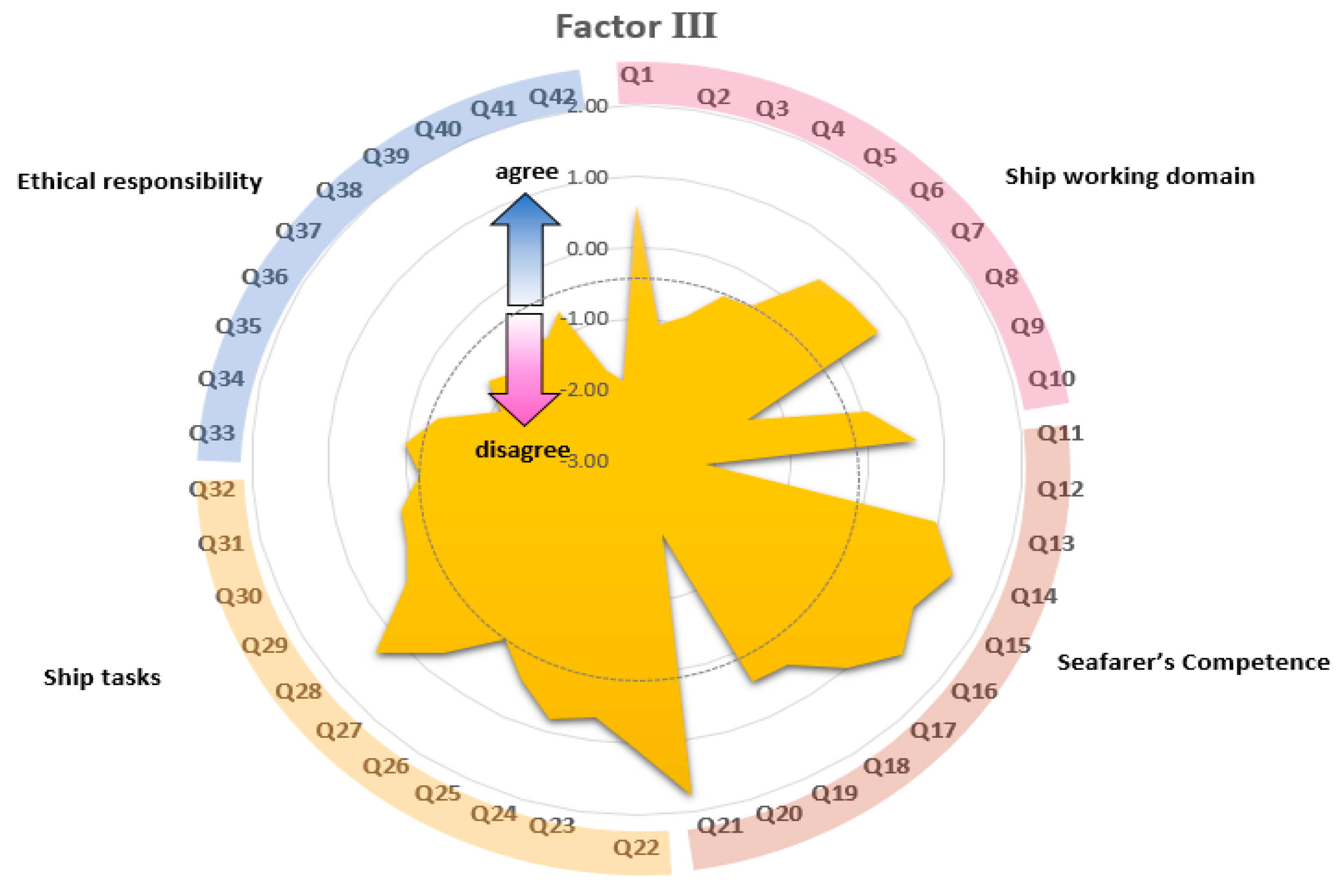1. Introduction
Industry 4.0, a German strategic initiative, is the ongoing transformation of manufacturing and industrial practices, combined with the dynamic development of technology [
1]. The term Industry 4.0 is often referred to as the Fourth Industrial Revolution [
2,
3,
4]. Ever since the introduction of the Fourth Industrial Revolution concept at the 2016 Davos Forum, efforts are being made across industries to implement the concept in practice. Industry 4.0 is being implemented simultaneously across several maritime industries, including shipping (Shipping 4.0), port (Port 4.0), shipbuilding (Smart ship 4.0), and marine (Marine 4.0) [
5,
6,
7,
8,
9]. Among these, the Maritime Autonomous Surface Ship (MASS) is gaining attention for posing a new challenge to innovative growth technology [
7,
9]. At the same time, it is expected to be the growth engine of the next-generation marine industry.
The Maritime Safety Committee (MSC) of the International Maritime Organization (IMO) defines MASS as “a ship that operates at various levels independent of human interference” [
10] and identifies the following four levels: (Level 1) decision-making support by seafarers; (Level 2) boarding of seafarers, remote control; (Level 3) minimum number of members on board, remote control, and engineering automation, such as failure prediction and diagnosis; and (Level 4) fully unmanned autonomous operation. In a low-level automation state, the system merely collects information, while the seafaring members analyse and determine the nature of the collected information, and act accordingly. As the level of autonomy increases, the role of the humans decreases, and the system performs almost all functions, except those needed in an emergency. Major countries in the world are currently developing the MASS system at each level, and accordingly, the role of workers in the shipping industry is changing significantly.
Frey and Osborne [
11] ranked 702 jobs across industries that are likely to be automated and quantified the potential and impact of technological innovation on unemployment. According to this study, specifically to the maritime industry, officers who directly operate a ship fall into the low-risk category as the risk of automation is relatively low, at 0.01, where 1 represents a job that is at risk of automation and 0 represents a job at low risk of automation. In fact, according to the manpower report of BIMCO/ICS [
12], from 2010 to 2015, the global demand for seafarers has seen an overall increase, with higher demand for officers than for ratings. This implies that manpower with advanced knowledge is required to handle increasingly automated ships. Further, demand for highly qualified officers are predicted to continuously increase, as the demand for large high-end ships continue, and until a fully unmanned MASS is developed and commercialized. With the advancement in unmanned ship technology, not only will members who form a part of a ship’s crew change, but also the whole organizational structure will see a marked change with a corresponding shift in the work division. Therefore, competency of officers is expected to change significantly.
In this study, a survey was conducted on the perception of prospective officers towards such changes. Trainee navigational deck officers and engineering officers holding the Officer of the Watch (OOW) certificate, and currently enrolled as students at the Korea Maritime and Ocean University (KMOU), were selected as the participants of this study. We analysed students’ perceptions about new seafarers’ requirements in the era of MASS in terms of a ship’s organization, tasks, seafarers’ competencies and ethical responsibilities. By applying a Q methodology, we were able to extract potential new abilities required for future officers, thus predicting the competencies that will be demanded and the development of new curricula in the field of education and training.
Such predictions are important to guarantee a stable supply of high-quality officers suitable for the era of MASS operations to the whole shipping industry and, indirectly, to avoid disruption across supply chains in international trade. This study can help maritime educational institutions that are currently training cadets in establishing a direction for future maritime education by clarifying the requirements for seafarers’ job for the MASS era. Further, based on the study’s findings, maritime educational institutions can re-think and adapt existing curriculum for future maritime education. The study can thus significantly contribute to stabilizing the future seafarers’ supply for the shipping industry.
The Future of Jobs’ report released at the Davos Forum predicted that the Fourth Industrial Revolution will eliminate 7.1 million jobs and create 2.1 million new jobs by 2020, eventually eliminating 5 million jobs [
13]. Further, it predicted that autonomy technology (via machines) will perform more work than humans in 2025 [
14]. In the shipping industry, if MASS is commercialized, jobs in the marine industry as well as seafarers’ jobs are expected to change quantitatively and qualitatively [
9,
10,
11,
12,
13,
14,
15].
The Korean Ministry of Trade, Industry and Energy conducted a survey on the status of industrial technical manpower in four promising new industries as of 2018: digital healthcare, smart and eco-friendly ships, aerial drones and intelligent robots. The survey revealed that 168,000 workers will be needed by 2028 in these four industries. Especially in the case of smart and eco-friendly ships in the shipping industry, the number of technical personnel required was 35,549 as of 2018. The shortage rate was 2.6%; and 49,000 people are required by 2028 owing to domestic and foreign environmental regulations and the demand for autonomous ship development personnel. Thus, the demand for new manpower in the shipping industry is expected to increase manifold with the technological advancements [
16].
As new technologies implemented on ships become increasingly important in the maritime industry, there may be a decrease in the number of seafarers required in the future. Based on a prior study by Jatau [
17] and Kim et al. [
18], it was suggested that if MASS is implemented, seafarers would face the threat of losing their jobs or a further shrinking in a manpower structure where unskilled workers are not required; instead, only able seamen or officers are likely to be in demand. In a similar study, Kevin Tester [
19] argued that the introduction of MASS tends to change the job profile rather than eliminate jobs, thus creating new types of jobs, bringing greater prosperity to the industry. Thus, there will be a gradual decrease in jobs in the seafarer-related industry with the technological development and expansion of MASS; however, other types of jobs, different from the present ones, will be created [
9,
20]. MASS is expected to create a demand for new highly advanced skills among seafarers boarding a ship equipped with advanced technology, which will mark the future of the shipping industry [
15]. Jo and D’agostini [
21] argued that a full-scale implementation of MASS, under four different scenarios, will result in a loss of seafarers’ jobs, but a larger positive effect will create new shore-based employment within the maritime industry.
Rodseth and Burmeister [
22] claimed that the development of an unmanned ship can provide new job opportunities to competent seafarers. Baldauf et al. [
23] conducted a simulation analysis to determine whether a seafarer with experience at sea or a skilled information-technology worker is more suited to navigation control and monitoring of the MASS; the study also presented the necessary abilities and knowledge that future seafarers should possess. Specific suggestions regarding this can be found in the study by Cicek et al. [
24]. Based on studies by Hecklau et al. [
25] and Cicek et al. [
24] a new category of future competence required for seafarers with the advent of the Fourth Industrial Revolution technology was reconstructed. Functional and behavioural competencies were identified as important for seafarers, where functional competency was related to technical skills required for ensuring the safe navigation of the ship, and individual competency related to communication skills, teamwork, leadership and language skills required for maintaining ship safety. Cicek et al. research analysis was the basis for the present study in identifying abilities required for future seafarers and were included in the selected Q-statements.
Shenoi et al. [
15] claimed that the introduction of MASS is inevitable, and that the shipping industry should brace itself to develop a new business model for shipbuilding, manufacturing, repair and maintenance and operations. According to their study, this change is expected to affect the education and training for technical engineers, seafarers, shipping companies, ship management companies and shipbuilding. The study explains that for a ship’s operation to become fully unmanned, that is, without human intervention partially controlling the system, the Shore Control Center Operator (SCCO) should possess a high level of skills. The emergence of a SCCO who intervenes in decision-making and provides operational information is essential for the ship’s operation beyond the existing ship control level will significantly change the quality of seafarer-related jobs [
8,
11,
15,
26]. Further, Shenoi et al. [
15] emphasize the importance of education and training in accordance with the change in the new technologic implemented ship.
Ship technology development and the emergence of MASS are expected to change the operational characteristics and tasks on existing ships. Human resources highly skilled in technology will be required when high-level mechanization and automation become commercialized in ships with the advancement of science and technology [
24]. Thus, understanding the future human resources in the maritime industry is important, especially for maritime educational institutions, to develop a new perspective to reform maritime training and educational activities to meet the need for highly qualified officers [
9]. With the expected increase in demand for highly skilled workforce for unmanned ships, an officer will no longer be termed a seafarer, but an “e-farer”, controlling the operations of a ship through technology [
27]. Lee et al. [
28] defined a seafarer in Industry 4.0 as seafarer 4.0. Seafarers who operated a ship in the traditional manner were called 1.0, those who operated a ship with power were termed 2.0, those who controlled a ship equipped with automation equipment (when the role of seafarers began to increase), such as automatic navigation and automatic identification detection device, were termed 3.0., and those who controlled an unmanned ship were termed 4.0.
With the advancement in technology, the shipping industry may require skilled workforce to undertake new kinds of tasks with the elimination of old tasks to operate a state-of-the-art ship. Although the number of jobs may decrease, the tasks on MASS are not limited to existing maritime knowledge and technology. They also include analysing or monitoring big data and using information and communication technology (ICT) of the digitized ship. Seafarers who can use computer technologies [
29] and demonstrate adequate teamwork and leadership skills will be in demand for future ships. Therefore, the changes that are expected to impact the whole industry are likely to be very significant in terms of degree and magnitude and will most certainly indirectly involve the sustainability of maritime education and training organizations.
The present study classified the subjectivity types of the prospective officers by applying the Q method, considering their suitability and ability to adapt in the era of MASS, and investigated the characteristics of each type, thereby deriving the concept of a future navigational and engineering officer. It presents an in-depth study on the educational direction that maritime educational institutions should take to foster shipping workforce that can stably operate MASS, and it provides basic data related to policymaking in the shipping industry. The results obtained can thus serve as basic data for institutions in establishing a direction for education and research and implementing specific training courses so that the shipping industry operations can remain competitive in the future.
5. Conclusions
This study focused on investigating the perception of maritime cadets toward the changing job requirements for seafarers with the introduction of MASS. This research is the first attempt to qualitatively analyse the standpoints on the subject from students’ perspectives. As the development of autonomous ships is expected to gradually decrease the number of seafarers on board, this study can contribute towards understanding the attitude and impressions of maritime cadets on the issue and help drawing educational policies. In this study, we utilized the Q methodology to extract and cluster the opinions of the respondents and there are three main findings.
First, we extracted three specific factorial types out of the analysis, each one with peculiar statistical patterns. Factor I (traditional seafarers’ centric role retainer) perceived that seafaring will continue to be a necessary occupation and central to the operation of a ship even with automation and mechanization. On the other hand, factor II (the ship organizational structure domain achiever) predicted that a change in seafarers’ jobs and employment in the ship’s internal organization and working domain are all likely to occur. Factor III (the new technical competences builder) perceived that although seafarers’ jobs and employment would undergo a change, the level of competence required in the job would be higher. Although the three factors suggest mixed and heterogeneous findings, it is safe to argue that a radical change in seafarers’ competences is the main element extracted out of the analysis. A major implication of this new paradigm shift in seafarers’ competencies will most likely involve maritime education and training centres. Maritime-related universities and institutes will need to act proactively in adapting their curriculum to new requirements, for seafarers to remain competitive regionally and globally. For future seafarers or e-farers, high-tech jobs such as maintenance and repair in an unmanned environment, cargo security equipment, automatic handling of transshipment between vessels, cyber security service, and remote operation of automated equipment including port cargo handling, are expected to be created. With the operational characteristics of the new type of ship, the competency requirements for a specific task will also vary accordingly. Consequently, MET will need to structurally re-think the educational framework prioritizing the training of specific skills and tasks in a new curriculum.
Second, all the three factors shared common views on some of the proposed statements. In particular, all groups agreed on the fact that new technologies will change the seafaring market in terms of employment (Q9), traditional competences (Q12, Q20) and ability to respond to emergencies (Q21). Therefore, we can safely assume that seafaring will most likely still be central to the operation of a ship even in the MASS era, but seafarers would require new capabilities both in the form of hard skills and soft skills. Within hard skills, it appears that there will likely be a shift from purely technical skills to information and communication technologies such as big data and analytics. Although STCW Convention (International Convention on Standards of Training, Certification and Watchkeeping for Seafarers) has been amended and included a set of soft skills needed in the education and training of seafarers as leadership, teamwork and languages, the introduction of MASS will require new competencies such as emergency response, self-management and stress management.
Third, demographics, such as gender and, to a greater extent, the major of the participants, loaded significantly across the three factors. Interestingly, factor I was dominated by male respondents enrolled in engineering major. They perceived that seafaring will continue to be a necessary occupation and central to the operation of a ship even with automation and mechanization. In contrast with it, factor II was mainly loaded with respondents majoring in navigation. They predicted that a change in seafarers’ jobs and employment, in the ship’s internal organization and working domain, are all likely to occur. Factor III was overall more balanced between respondents as they perceived that, although seafarers’ jobs and employment would undergo a change, the level of competence required in the job would be higher. In other words, the quality of a seafarer’s competency is expected to change. Thus, these findings suggest that the perceptions of respondents toward new seafarers’ competencies in the MASS era differ and gender and educational major are key elements in clustering their beliefs.
Ultimately, the introduction of MASS is not simply an advancement in science and technology, but a systemic change across the shipping industry. Thus, qualitative changes in the seafarer workforce market require a workforce development strategy. The results of this study can provide sufficient direction for such manpower development and training officers.











